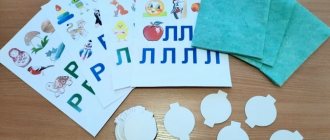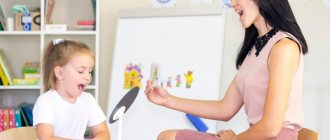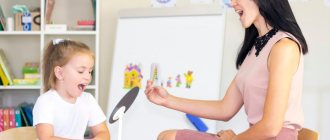Documentation of a speech therapist at a preschool educational institution according to the Federal State Educational Standard
Documentation of a speech therapist at a preschool educational institution according to the Federal State Educational Standard
First of all, you need to look at the documents of the speech therapist teacher, which were developed by the creative team at the methodological association.
First of all, what concerns correctional and speech therapy work on the part of the administration of the preschool educational institution:
· Regulations on correctional and speech therapy work
· Regulations on logopoint and logogroup.
· Regulations on PMPK
· Regulations “On the interaction of a speech therapist with parents of children with speech disorders”
· Regulations “On the interaction of a speech therapist with specialists of a preschool educational institution”
· Job description of a speech therapist and speech therapy group teacher.
Next is what should be directly in the documentation of a speech therapist at a preschool institution. For successful effective work, a speech therapist must have the skills to correctly and competently conduct documentation. This will make it possible to effectively and rationally plan the course of correctional training, taking into account speech disorders, their psychophysiological characteristics, and clearly record the stages of speech therapy support. The presence of basic types of documentation is a prerequisite for the work of a speech therapist; the correctness of its management is assessed and is one of the decisive moments in determining the qualification category of a speech therapist. Basic documentation of a speech therapist teacher should include:
1. Cabinet passport
. Where the speech therapist teacher completely prescribes all the zones in the office and their equipment. Regardless of whether there is a separate office or not. Includes a list of everything that a speech therapist has:
- equipment
— visual, educational and methodological aids
— textbooks and methodological literature
— didactic games and simulators
Can be presented in the form of diagrams, tables, drawings by sections or centers (depending on the creativity of the speech therapist)
2. Children's register
in need of correctional assistance. Children enrolled in speech therapy groups or at a speech center must be registered in a logbook, which is kept separately by each speech therapist
3. Journal of primary examination of children's speech
. (1 for two). Every year, the institution examines children to identify those in need of speech therapy help. The results of the examination are recorded in the journal of the primary examination of the speech of preschool children. Children with speech underdevelopment in the middle, senior and preparatory groups are sent to the PMPK to staff speech therapy groups or a speech center. For children of younger groups with severe speech underdevelopment, with malocclusion, short hyoid ligament, and stuttering, parents and their parents are invited to see a speech therapist for consultation, referral to specialists for examination and treatment.
4. Speech cards
. There are 2 types of speech cards for children with OHP and FFN. Speech cards are filled out by a speech therapist for each child during the month of September based on the results of a speech therapy examination. Errors and shortcomings made by children when completing tasks are entered into the map. Speech samples with their lexico-grammatical and phonetic errors must be recorded. The speech card must be accompanied by:
- pedagogical characteristics compiled by the teacher of the group that the child attended before entering the speech therapy group or speech center;
- certificate (extract from the medical record with the conclusion of a psychoneurologist, ophthalmologist and otolaryngologist).
At the end of the examination, a speech therapy report is formulated in the speech card in accordance with the recommendations for speech therapy diagnostics and a long-term plan for individual work with the child for the period of study is drawn up. At the end of the school year, the speech card must indicate the result of speech therapy work: what violations still exist, what aspects of the speech process require consolidation or clarification.
5. Summary table for children's speech diagnostics
speech therapy group or speech center. In our preschool educational institution, speech therapists prepare such cards for each age group
6. Annual work plan
, approved by the head of the educational institution. It is written in 2 copies (which 1 from the speech therapist teacher, 2 is attached to the annual plan of the preschool educational institution) At the end of the school year, an annual work plan is drawn up, which includes the following sections:
- examination of children’s speech, it indicates the work of filling out speech cards and completing documentation
— staffing groups and subgroups, scheduling speech therapy classes
- directions, tasks and main content of correctional work by sections, in accordance with the areas of work
— interaction between a teacher-speech therapist and a teacher of groups (regular and speech therapy); with specialists from preschool educational institutions (psychologist, music director, art teacher, etc.). Work with parents for the school year is also prescribed (parent meetings, consultations, open speech therapy classes, design of corners for parents and stands, etc.)
— measures to improve the equipment of the speech therapy room with educational and methodological aids, didactic and visual material, etc.
— advanced training of a speech therapist teacher (attendance at courses, methodological associations, conferences, questions on self-education, certification, etc.)
— action plan aimed at preventing speech disorders in children
7. Long-term plan for corrective work
. Compiled for the academic year (quarter, month). If a speech therapist teacher works with children of the same age and with the same speech disorders, one long-term plan is drawn up; If you work with children who have different speech disorders or attend different age groups, long-term plans are drawn up for each subgroup of children.
8. Calendar-thematic plan for frontal classes
. It is compiled on the basis of the program used by the speech therapist.
9. Schedule of speech therapy classes
for a week. After a comprehensive examination of children’s speech, a schedule of classes is drawn up, which reflects all types of speech therapy classes (frontal, subgroup, individual).
10. Daily work plan
. The title page of the plan indicates the number of the preschool educational institution, the academic year, and the name of the speech therapist. The plan can be kept in the form of a journal, which contains the following columns:
- date
- surname, first name of the child
— form of class (industrial, subgr., frontal)
- summary of lessons
The plan indicates all types of work that are carried out by a speech therapist on a given day (examination of children’s speech, filling out speech cards, conducting diagnostics, preparing speech therapy corners or booklets, conducting consultations, speaking at parent-teacher meetings, teacher councils, participating in entertainment, matinees, attending methodological associations, etc.)
11. Frontal training plan
. Making plans for each lesson is mandatory. The plan indicates the topic, goal and objectives, equipment and progress of the OA
12. Children's attendance notebook for speech therapy classes
. The attendance notebook contains the entire list of the speech therapy group or speech center. If a child has not attended kindergarten for a long time, it is recommended to indicate the reason for not attending.
13. Individual notebooks for children
. Individual notebooks are filled out by a speech therapist for each child. They record the date of the lesson and approximate content. Notebooks are colorfully designed (with the participation of parents). On weekends, children take notebooks home to do homework, and on normal days the teacher works on the notebooks
14. Teacher's Evening Activities Notebook
. The speech therapist's assignments and an analysis of the work carried out by the teacher are recorded in the notebook. The analysis indicates how successfully the children have mastered the material and what difficulties they encountered when completing the tasks. All types of tasks should be familiar to children. These can be individual articulation exercises, repetition of texts and exercises selected earlier with a speech therapist, exercises to develop attention, memory, phonemic awareness, the formation of lexical and grammatical aspects of speech, etc. The notebook is filled out by a speech therapist at least once a week. The teacher keeps records of the work done. Evening classes should not include sound production exercises.
15. . Annual report on the effectiveness of correctional work for the academic year
(over the last 3 years). This is a report on the performance of the speech therapist for the year, which is submitted to the education committee. The report is certified by the manager. One copy remains with the speech therapist, 1 with the methodologist, 1 with the KO.
16. Working programm
, developed by a speech therapist, based on the general education program of the preschool educational institution and the corresponding correctional ones.
17. Interaction Notebook
with teachers and a plan for interaction with preschool specialists.
· Organize an information stand in the reception areas of each group (“useful information corner for parents”). Information must be systematically updated. Also, the speech therapist should have an information corner like: “What did we do today,” where parents should be informed daily about the lessons completed with their children.
The main areas of a speech therapist's office using specific examples.
Most speech therapy rooms are located in outdated standard kindergarten buildings and are located in small, unsuitable premises (former storerooms, corridors, etc.
Let's consider the correctional and developmental environment of speech therapy rooms
• A training area for conducting subgroup correctional classes, including children’s work stations, wall panels and demonstration surfaces.
• A sound correction zone or an area for individual work requires the presence of a wall mirror, a rack for tools, games and aids, devices for breathing exercises, massage, etc.
• The work area of the speech therapist teacher is equipped with a table, chair, tape recorder with audio recordings, CDs; training programs, computer.
In the storage area of visual didactic aids and documentation of the teacher-speech therapist there are the necessary visual and methodological aids, methodological literature on production, automation and differentiation of defective sounds; cards with articulatory patterns of speech profiles (whistling, hissing, sonorous); visual material, sets of breathing exercises, didactic games, etc.
Documents of the teacher of the speech therapy group
— a summary statement of the results of diagnosing sound pronunciation in children
— notebook of interaction with a speech therapist teacher
— notebook of speech therapy hours notes
— card file of individual lessons with children with card numbers
— card files of speech games and exercises with children.
Monitoring correctional and speech therapy work in preschool educational institutions
Control is the most important management function, including in a preschool educational institution. Currently, a large amount of literature and various publications have appeared in periodicals devoted to the organization of control over the educational process in preschool educational institutions.
Based on the fact that the main functions and types of control are the same, our attention is focused on the development of control algorithms for various types of activities of a speech therapist teacher, in the following areas:
1. Organization of a speech therapy room.
2. Maintaining mandatory documentation.
3. Corrective work with children: a) frontal; b) individual.
4. Work with educators.
5. Work of the teacher with children of the speech therapy group
6. Working with parents.
To prepare control documents, we used the idea of a tabular form for maintaining control materials, proposed by many authors (K. Yu. Belaya, O. A. Skorolupova, etc.) and adapted to the work of a preschool teacher-speech therapist.
The tabular form of presentation of materials is the most universal, as it allows you to easily change the content of the control depending on the purpose and tasks set by the inspector. The rating scale can also have several options (verbal, color, point, percentage).
As practice has shown, control has a positive effect on the pedagogical process, has a beneficial effect on the organization of all activities of the speech therapist and teacher of the speech therapy group, increases their responsibility for the level of education, correction and upbringing of children, and promotes the interest of teachers in improving their professional skills.






